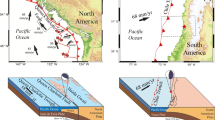Abstract
We propose a rapid, finite-fault inversion procedure to derive first-order estimates of the coseismic slip following large Mw > 7 earthquakes in Mexico using teleseismic P waves obtained in near real time. The procedure uses kinematic fault parameters and waveform properties prescribed based on the magnitude of the event. Two consecutive inversions are performed, one for each of the two nodal planes in the earthquake source mechanism, allowing an automated analysis of the P-wave dataset with minimal manual intervention. Following the inversion process, the appropriate slip model is selected based on seismotectonic considerations in the earthquake source region. The inversion procedure was applied to the Mw 7 Acapulco subduction earthquake of 8 September 2021 using the source parameters posted online by the U.S. Geological Survey (USGS), resulting in the derivation of a preliminary, first-order source model within 1 h after the event. The slip model shows a single source region similar to the rupture area observed by the USGS using body- and surface-wave records. We also conducted a rapid analysis of the teleseismic P waves available for the Mw 8.2 normal-faulting Chiapas earthquake of 8 September 2017 and recovered a slip model comparable to the finite-fault model obtained by the USGS for that event. For both earthquakes, the time required for waveform retrieval and analysis was less than 5 min, indicating that the procedure can be used to derive timely, preliminary slip models for large Mexico events that would be useful for earthquake early alerting and post-earthquake response.





Similar content being viewed by others
References
Ammon CJ, Velasco AA, Lay T (2006) Rapid estimation of first-order rupture characteristics for large earthquakes using surface waves: 2004 Sumatra-Andaman earthquake. Geophys Res Lett 33:L14314. https://doi.org/10.1029/2006GL026303
Crotwell HP, Owens TJ, Ritsema J (1999) The TauP toolkit: flexible seismic travel-time and ray-path utilities. Seism Res Lett 70:154–160
Dreger DS, Gee L, Lombard P, Murray MM, Romanowicz B (2005) Rapid finite-source analysis and near-fault strong ground motions: application to the 2003 MW 6.5 San Simeon and 2004 MW 6.0 Parkfield earthquakes. Seism Res Lett 76:40–48
Hartzell SH, Heaton TH (1983) Inversion of strong ground motion and teleseismic waveform data for the fault rupture history of the 1979 Imperial Valley, California, earthquake. Bull Seism Soc Am 73:1553–1583
Hayes GP, Earle PS, Benz HM, Wald DJ, Briggs W, and the USGS/NEIC Earthquake Response Team (2011) 88 hours: the U. S. Geological Survey National Earthquake Information Center Response to the 11 March 2011 MW 9.0 Tohoku Earthquake. Seism Res Lett 82:481–493
Helmberger DV, Harkrider D (1978) Modeling earthquakes with generalized ray theory. In: Miklowitz J, Achenbach JD (eds) Modern problems in elastic wave propagation, John Wiley and Sons, New York, pp 499–518
Ji C, Helmberger DV, Wald DJ (2004) A teleseismic study of the 2002 Denali fault, Alaska, earthquake and implications for rapid strong-motion estimation. Earthq Spectra 20:617–637
Kennett BLN, Engdahl ER (1991) Travel times for global earthquake location and phase identification. Geophys J Int 105:429–465
Mendoza C (1993) Coseismic slip of two large Mexican earthquakes from teleseismic body waveforms: Implications for asperity interaction in the Michoacan plate boundary segment. J Geophys Res 98:8197–8210
Mendoza C (1996) Rapid derivation of rupture history for large earthquakes. Seism Res Lett 67:19–26
Mendoza C (2014) Near-realtime source analysis of the 20 March 2012 Ometepec-Pinotepa Nacional, Mexico earthquake. Geof Int 53:211–220
Mendoza C, Hartzell S (2013) Finite-fault source inversion using teleseismic P waves: Simple parameterization and rapid analysis. Bull Seism Soc Am 103:834–844
Mendoza C, Castro Torres S, Gomez Gonzalez JM (2011) Moment- constrained finite-fault analysis using teleseismic P waves: Mexico subduction zone. Bull Seism Soc Am 101:2675–2684
Okuwaki R, Yagi Y (2017) Rupture process during the MW 8.1 2017 Chiapas Mexico earthquake: shallow intraplate normal faulting by slab bending. Geophys Res Lett 44:11816–11823. https://doi.org/10.1002/2017GL075956
SSN (2017) Sismo de Tehuantepec (2017-09-07 23:49 MW 8.2), Reporte especial, Grupo de trabajo del Servicio Sismológico Nacional, Institute of Geophysics, Universidad Nacional Autónoma de Mexico, retrieved 6 July 2021, http://www.ssn.unam.mx/sismicidad/reportes-especiales/
Stolte C, McNally KC, Gonzalez-Ruiz J, Simila GW, Reyes A, Rebollar C, Munguia L, Mendoza L (1986) Fine structure of a post-failure Wadati-Benioff zone. Geophys Res Lett 13:577–580
Acknowledgements
This work has benefitted from prior collaborative work with S. Hartzell. We thank J. Silva Corona for his assistance in the preparation of Figure 1 and also two anonymous referees whose comments helped improve the presentation of the results.
Author information
Authors and Affiliations
Corresponding author
Ethics declarations
Conflict of interest
The authors declare no competing interests.
Additional information
Publisher's note
Springer Nature remains neutral with regard to jurisdictional claims in published maps and institutional affiliations.
Rights and permissions
About this article
Cite this article
Mendoza, C., Martínez-López, M.R. Rapid finite-fault analysis of large Mexico earthquakes using teleseismic P waves. J Seismol 26, 333–342 (2022). https://doi.org/10.1007/s10950-022-10083-y
Received:
Accepted:
Published:
Issue Date:
DOI: https://doi.org/10.1007/s10950-022-10083-y




